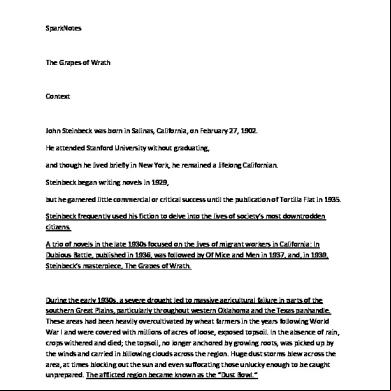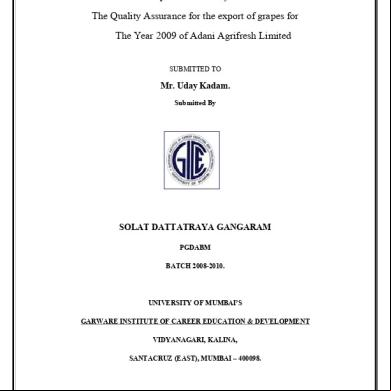Grapes Chart 5t3kv
This document was ed by and they confirmed that they have the permission to share it. If you are author or own the copyright of this book, please report to us by using this report form. Report 3b7i
Overview 3e4r5l
& View Grapes Chart as PDF for free.
More details w3441
- Words: 331
- Pages: 1
Unit 1:GRAPES Chart Civilization:
Ch.2: Sumerians, Babylonians, assyrians, Hebrews, Israelites, Jews, Phoenicians, IndoEuropeans
Ch.3: Kush, Nubians, Bantu, Egyptians
Ch.4: Harappan, Aryans
Ch.5: Olmec, Maya, Teotihuacan, Andean, Chavin Cult
Ch.6: Austronesians, New Guinea
Geography:
Black Sea & Caspian Sea, Russia, Egypt, Syria, Babylon Mesopotamia, Tigris & Euphrates river, modern-day Iraq
Sub-saharan Africa, Egypt, Nubia, eastern Sudan
Indus River valley,north India, Himalayas mt., Hindu Kush, Harappa and Mohenjo-Daro
Yellow River & indus river, Plateau of Tibet, modernday province of Henan
Southernmost South America, Gulf of Mexico, Guatemala, Peru & Bolivia
Religion:
Developed monotheistic, Astarte (phoenicians), Yahweh (hebrews,jews)
Associated pharaohs with Gods, Cult of Amon & Re & Aten(gods), Mummification, Monotheistic (Bantu),
Related to fertility-Aryan religion, Indra, Fertility cults (hinduism), Monotheistic, Believed in afterlife
Mandate of heaven/ son of heaven & deities
Popol Vuh, rituals/ sacrifices, mayan ball game, Chavin cult
Achievements:
irrigation/ canals, city walls, temples/ ziggurats, agriculture, Hammurabi’s law, writing, metallurgy, the wheel, ship building, Sanskrit
Agriculture, Nubian realm/small kingdoms,cities, pyramids,temples/ palaces, statues, bronze weapons/ chariots(later into iron),tombs, Trade, Metallurgy, hieroglyphic writing, Language
writing(not translated)/sanskrit & Prakrit, Lawbook of Manu, iron tools, agriculture, cities with own citadel, temples, Trade, 4 vedas
Fine painted pottery, bone tools,writing (oracle bones), Trade, Metallurgy
agriculture/ villages, ceremonial centers, complexes, pyramids, calendar, math(zero), writing, astronomy, irrigation
Politics:
Military defense, conflicts/wars against others, fell under control from empires
Major cities, affairs, Thebes became istrative center of Upper Egypt
Shared agricultural surplus, several jobs (craftsmen, advisors, metalsmiths, etc), had allies, specialized labor,
Political centers, conflicts
Economics:
trade
Tax,trade with Nubians,North, & Africa, transportation, Small Kingdom
Pastoral economy,trade
Controlled and used surpluses for military forces, trade
Trade, cacao seeds(money)
Social Structure:
Ruled by Sumerian kings, laborers recruited by authority, patriarchal
Pharaoh gains power, army/ s, peasants/slaves, patriarchal
raja(king), dasas (indigenous), 4 varnas + untouchables, -Patriarchal and patrilineal, Based on Lifestyle, Jati
Based on three dynasties(Xia, Shang,& Zhou) ruled by family, sizeable class of slaves, Patriarchal,
Hierarchical,kings/ priests & warriors (prestige), captives (slaves/ victims)
-No evidence regarding royal or imperial authority-
Ch.2: Sumerians, Babylonians, assyrians, Hebrews, Israelites, Jews, Phoenicians, IndoEuropeans
Ch.3: Kush, Nubians, Bantu, Egyptians
Ch.4: Harappan, Aryans
Ch.5: Olmec, Maya, Teotihuacan, Andean, Chavin Cult
Ch.6: Austronesians, New Guinea
Geography:
Black Sea & Caspian Sea, Russia, Egypt, Syria, Babylon Mesopotamia, Tigris & Euphrates river, modern-day Iraq
Sub-saharan Africa, Egypt, Nubia, eastern Sudan
Indus River valley,north India, Himalayas mt., Hindu Kush, Harappa and Mohenjo-Daro
Yellow River & indus river, Plateau of Tibet, modernday province of Henan
Southernmost South America, Gulf of Mexico, Guatemala, Peru & Bolivia
Religion:
Developed monotheistic, Astarte (phoenicians), Yahweh (hebrews,jews)
Associated pharaohs with Gods, Cult of Amon & Re & Aten(gods), Mummification, Monotheistic (Bantu),
Related to fertility-Aryan religion, Indra, Fertility cults (hinduism), Monotheistic, Believed in afterlife
Mandate of heaven/ son of heaven & deities
Popol Vuh, rituals/ sacrifices, mayan ball game, Chavin cult
Achievements:
irrigation/ canals, city walls, temples/ ziggurats, agriculture, Hammurabi’s law, writing, metallurgy, the wheel, ship building, Sanskrit
Agriculture, Nubian realm/small kingdoms,cities, pyramids,temples/ palaces, statues, bronze weapons/ chariots(later into iron),tombs, Trade, Metallurgy, hieroglyphic writing, Language
writing(not translated)/sanskrit & Prakrit, Lawbook of Manu, iron tools, agriculture, cities with own citadel, temples, Trade, 4 vedas
Fine painted pottery, bone tools,writing (oracle bones), Trade, Metallurgy
agriculture/ villages, ceremonial centers, complexes, pyramids, calendar, math(zero), writing, astronomy, irrigation
Politics:
Military defense, conflicts/wars against others, fell under control from empires
Major cities, affairs, Thebes became istrative center of Upper Egypt
Shared agricultural surplus, several jobs (craftsmen, advisors, metalsmiths, etc), had allies, specialized labor,
Political centers, conflicts
Economics:
trade
Tax,trade with Nubians,North, & Africa, transportation, Small Kingdom
Pastoral economy,trade
Controlled and used surpluses for military forces, trade
Trade, cacao seeds(money)
Social Structure:
Ruled by Sumerian kings, laborers recruited by authority, patriarchal
Pharaoh gains power, army/ s, peasants/slaves, patriarchal
raja(king), dasas (indigenous), 4 varnas + untouchables, -Patriarchal and patrilineal, Based on Lifestyle, Jati
Based on three dynasties(Xia, Shang,& Zhou) ruled by family, sizeable class of slaves, Patriarchal,
Hierarchical,kings/ priests & warriors (prestige), captives (slaves/ victims)
-No evidence regarding royal or imperial authority-





